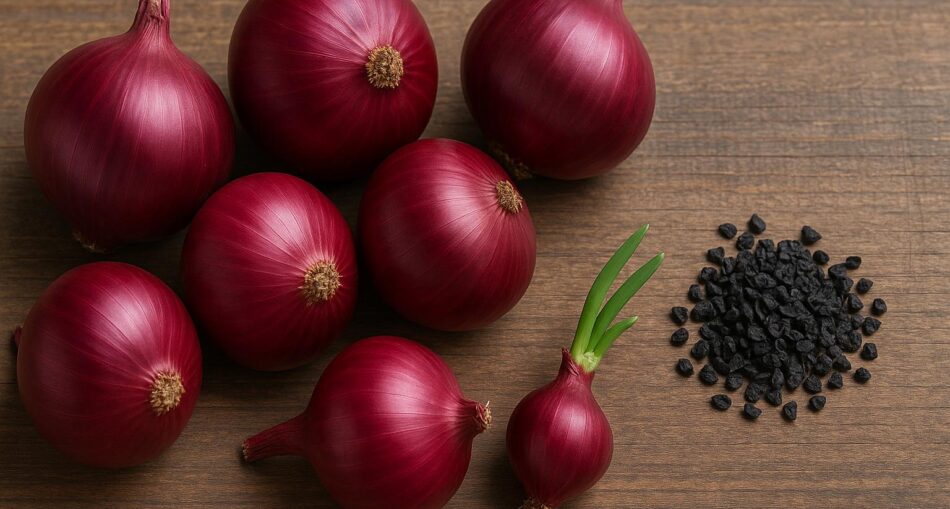What Makes a Red Onion Variety “Top Tier”?
To call a red onion variety top-tier, it must outperform others across several critical metrics:
- Germination speed and consistency under variable soil and climate conditions.
- Bulb uniformity, weight, and storability.
- Tolerance to common pests and fungal diseases.
- Maturity window aligned with regional harvest needs.
The majority of commercial growers seek out cultivars that can reliably yield bulbs weighing 80–120 grams, achieve full maturity in 100–130 days, and germinate in 5–7 days.
Allelopathy resistance (the ability to thrive near other competitive crops) and photoperiod plasticity (the capacity to adjust to varying day lengths) are two uncommon yet beneficial traits to look for.
N-53: Still the Workhorse for Indian and African Climates
The N-53 hybrid has earned its place as a farmer’s favourite due to its fast germination and impressive adaptability. Originally developed for semi-arid zones, this variety germinates reliably even under moderate water stress, a trait that many farmers in Kenya, Maharashtra, and northern Ghana appreciate during erratic rainy seasons.
With a maturity range of about 110 to 115 days, N-53 produces deep red, globe-shaped bulbs with thick skins that hold up well in transit and storage. In trials conducted across four Indian states, average yields ranged from 240 to 270 quintals per hectare, significantly exceeding regional averages.
For growers seeking to begin with proven genetics, it’s prudent to purchase N-53 hybrid onion seeds from a reputable supplier offering high-purity batches that minimize the risk of seed-borne diseases and uneven stands. This is a reliable launchpad for those seeking a balance of early germination and high tonnage at harvest.
High-Yielding Red Onion Varieties to Watch
While N-53 continues to dominate in many regions, several newer and region-specific varieties are gaining attention due to their unique strengths. Let’s dive into the ones turning heads among commercial producers.
Arka Kalyan
Developed by the Indian Institute of Horticultural Research, Arka Kalyan stands out for its short maturity (95–100 days) and tolerance to pink root disease. Its medium-sized bulbs, with a light crimson colour, are popular in southern India and parts of East Africa. This variety also resists bolting, a common issue that many growers face in warmer zones.
Red Creole
Originally bred in the U.S. but now popular across Africa and Southeast Asia, Red Creole is ideal for regions with hot, dry climates. Although its maturity window is slightly longer (120 days), it delivers consistent yields of 25–30 tonnes per hectare and shows strong resistance to thrips and purple blotch.
- Excellent for drier growing zones.
- Strong skin that supports long-term storage.
Red Creole’s niche? It thrives in regions where others fail due to its xerophilic resilience, a trait that helps it perform under limited water availability.
Bombay Red
Bombay Red is an open-pollinated, non-hybrid cultivar that thrives with little input and is popular in Ethiopia and Tanzania. Its rapid maturity (approximately 95 days) and local market preference maintain its demand, even though yields may vary depending on rainfall and soil quality.
A sustainable solution for multi-year use without repeating seed expenditures, it is also favoured by farmers who save seeds.
“Seeds don’t just carry life—they carry decisions. Every bulb in the ground is a gamble based on genetics, soil, and the grower’s judgment.”
Breaking Down Yield Performance vs. Germination Speed
Fast germination doesn’t always mean fast harvest, but it’s a crucial start. Varieties that germinate uniformly allow for more predictable crop management. This is especially important when you plan to stagger your harvests or integrate intercropping systems.
In southern Kenyan field tests, N-53 exhibited 91% germination rates 6 days after planting, whereas a local open-pollinated variety (OPV) achieved only 75%. N-53 had greater stand uniformity, which reduced labour and chemical treatment expenses even though the end output was similar (26 tonnes per hectare vs. 22).
Because of this, germination parameters are frequently given equal weight with yield by large-scale manufacturers. Your whole input schedule, from fungicide to fertiliser, becomes reactive rather than planned if your sprouting window is unpredictable.
You can consult this International Seed Testing Association reference on germination standards for vegetable crops for a more thorough explanation of these variables and testing procedures.
Storage Quality: Often Overlooked but Crucial
Although it can be easy to concentrate just on the harvest, post-harvest losses brought on by inadequate storage are a quiet yield killer. While specific onion cultivars may have tight skins but bruise readily during transportation, others yield large bulbs that decay more quickly.
If your crop travels via regional supply chains with few cold storage facilities, it’s crucial to know that red cultivars with thicker outer scales and a higher dry matter content tend to store longer. Under normal circumstances, N-53, Arka Niketan, and Red Coach (from a few international vendors) have all demonstrated a shelf life of up to four months with little sprouting.
Farmers frequently select cultivars with lenticel durability—a quality that enhances resistance to mould and soft rot during storage—in high-humidity regions.
FAQs
- What is the average seed rate per hectare for red onions?
Between 8 to 10 kg per hectare, depending on variety and sowing method. - Can I mix two onion varieties in the same field?
Not recommended. Variations in growth rate and maturity can lead to uneven harvests and increase the risk of pests. - What is the optimal soil pH for red onions?
Ideally 6.0 to 6.8. Acidic soils can lead to poor bulb development and increased disease incidence. - Are hybrid onions always better than open-pollinated ones?
Not always. Hybrids generally yield higher yields but are more expensive. OPVs are preferred for seed saving and lower-input farming. - Do red onions fetch better market prices than white or yellow ones?
Depends on region and season. In many African and Asian markets, red onions are the preferred choice in terms of consumer preference and pricing.







